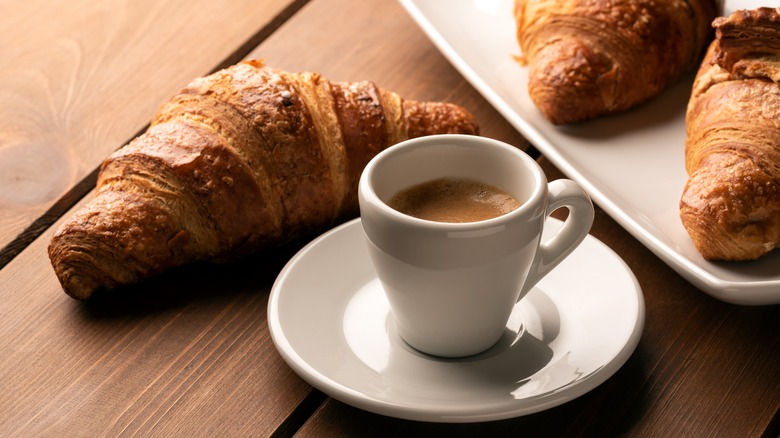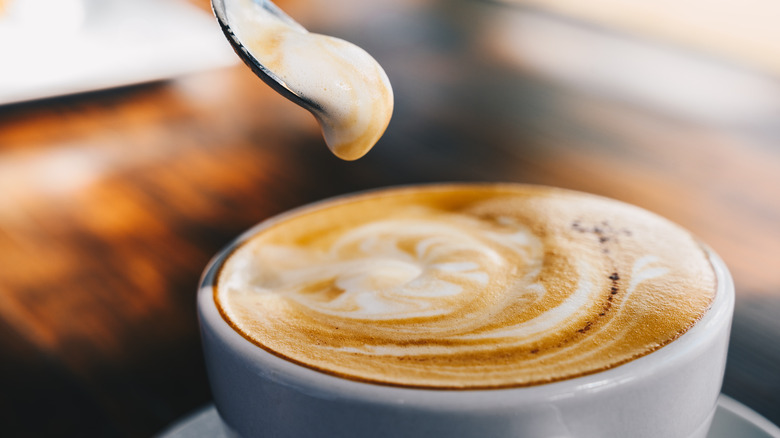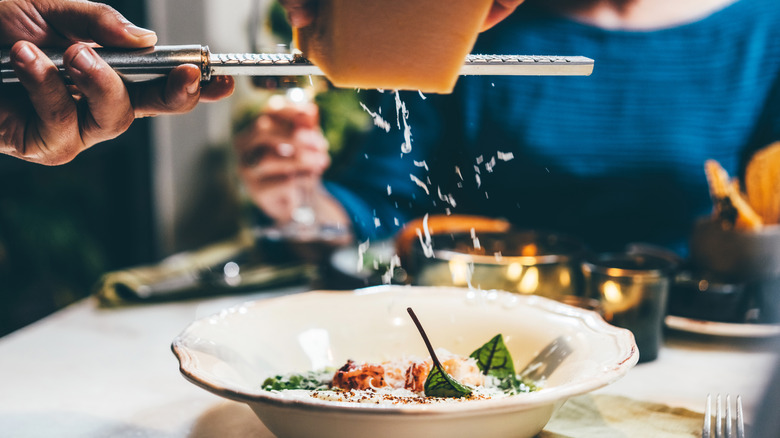This Is What You Might Eat For Breakfast In Italy
While you may associate Italian food with drawn-out meals of decadent dishes, it's a completely different experience in the morning. Breakfasts in Italy are literally short and sweet. The average Italian spends less than 15 minutes on eating in the morning, and it's typically a combination of a sweet pastry with coffee.
Italian breakfasts are all about fueling you with a quick burst of energy (and caffeine) instead of a heartier meal that will fill you up but also weigh you down at the start of the day. You won't find any loaded, savory breakfast plates with eggs, bacon, and toast like you'd be served in the United States. Instead, the typical Italian visits a bar (what is normally referred to as a cafe in the U.S.) and purchases a baked good and coffee to enjoy.
In the world of Italian breakfast pastries, there are lots of options. You can regularly find cornetto pastries (similar to croissants), either plain or stuffed with flavorful fillings like jam, flavored creams, or the classic Italian treat of Nutella. Speaking of the hazelnut spread, bread with Nutella is a popular breakfast option, particularly among Italian children. If you're having a coffee, it would be a great choice to enjoy a few biscotti or a slice of cake on the side. And beyond the bakery, it's pretty common to find fresh fruit and yogurt as options at restaurants and hotels.
Common coffee choices for Italian breakfast
It's not a real breakfast in Italy unless it's served up with a cup of coffee. If you enjoy a milky drink, early in the morning is the best time to order one without getting a raised eyebrow from your barista or waiter. There's an unspoken Italian rule that beverages like cappuccino aren't meant to be drunk after 11 a.m., as they're believed to negatively impact digestion. So get your fix while you can, before the clock strikes noon.
If you're wanting something creamy beyond a cappuccino, look to lattes. Caffe latte is mainly made of espresso with some milk added, while latte macchiato is mostly milk with some espresso added. Never order just a "latte," as that simply means "milk" in Italian. Depending on whether your barista speaks your language (or is in a grumpy mood that day), this misstep may end up with you drinking a steaming mug of plain milk.
And finally, it's never a bad time to drink an espresso in Italy; simply ask for a "caffe." These tiny little cups of concentrated coffee will give you just the right caffeine boost to spend your day being a tourist. Depending on the region you're in (particularly Naples, Liguria, or Piemonte), your espresso may come with a small glass of water to cleanse your palate before or after the coffee.
Italian dining etiquette rules for morning, noon, and night
Knowing the etiquette of Italian meals will help you stand out less as a tourist. In the morning, most locals will stand at the bar counter for breakfast. There are often tables and seating too, but the prices are normally higher there than if you stand. Although tipping is never required in Italy, it is appreciated if a small tip is left for seated meals, as they typically mean more work for the staff.
Most restaurants are open for lunch for only around two to three hours, then close for a break before dinner. Keep an eye on the clock throughout the day to avoid ending up hungry in the afternoon. Most Italians eat dinner later in the day, anywhere from 8 to 10 p.m., and restaurants open late too because of this. Anything open much earlier, such as 5 p.m., is likely a tourist trap that isn't eaten at by locals.
Italian meals have multiple courses, but you don't have to order all of them. Getting one of each is often reserved for special events, like celebratory dinners or wedding receptions. Instead, choose what you'd like from the options of antipasti (beginning appetizers), primi (soup, pasta, or risotto), secondi (proteins like fish or meat), contorni (salads or vegetables), and dolci (desserts, gelato, or fruit). As long as you don't commit the cardinal Italian sins of overloading your pasta with cheese or cutting spaghetti with a knife, you're sure to have a bellissimo meal.



